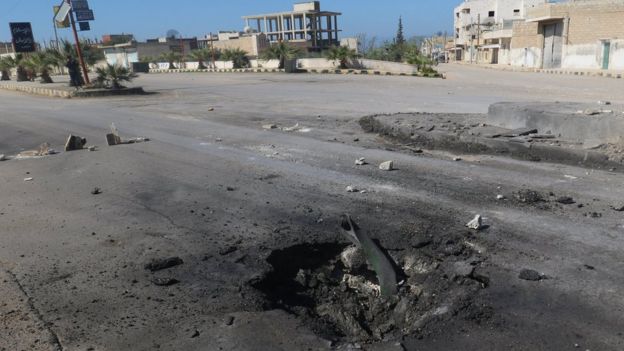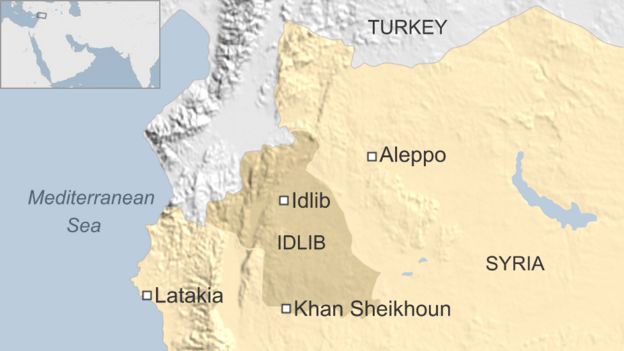 |
| Opposition activists said government warplanes dropped bombs containing chemicals |
Syria's government was responsible for a deadly chemical attack on a rebel-held town in the north-west of the country on 4 April, a UN report says.
The authors say they are "confident" Damascus used Sarin nerve agent in Khan Sheikhoun, killing more than 80 people.
"Today's report confirms what we have long known to be true," said the US ambassador to the UN, Nikki Haley.
Syrian President Bashar al-Assad and his ally Russia have repeatedly said the incident was fabricated.
Syria's opposition and Western powers have said it was a Syrian government air strike on the area.
But Damascus and Moscow say an air strike hit a rebel depot full of chemical munitions.
'Clear message'
The report findings were issued by the Organization for the Prohibition of Chemical Weapons (OPCW) and the UN's Joint Investigative Mechanism (JIM).
"The panel is confident that the Syrian Arab Republic is responsible for the release of Sarin at Khan Sheikhoun on 4 April 2017," stated the report, the AFP news agency reports.
Meanwhile, Ms Haley said in a statement: "Time and again, we see independent confirmation of chemical weapons use by the Assad regime. And in spite of these independent reports, we still see some countries trying to protect the regime. That must end now."
UK Foreign Secretary Boris Johnson said: "Britain condemns this appalling breach of the rules of war and calls on the international community to unite to hold Assad's regime accountable."
The UN director at Human Rights Watch, Louis Charbonneau, said that "today's report should lay to rest any discussion about who was responsible for the Khan Sheikhoun attack.
"The question now is whether Security Council and OPCW members, including Russia, will move to protect a key international rule and hold Syrian authorities accountable as they said they would."
Syria and Russia are yet to make public comments on the issue.
On Tuesday, Russia vetoed a resolution extending the JIM's mandate - the only official mission investigating the use of chemical weapons in Syria.
The report also said that so-called Islamic State (IS) was responsible for using sulphur mustard in an attack that in Um-Housh, Syria, on 16 September 2016.
What do we know about the Khan Sheikhoun attack?
Witnesses and activists say warplanes attacked Khan Sheikhoun, about 50km (30 miles) south of the city of Idlib, early on 4 April, when many people were asleep.
Mariam Abu Khalil, a 14-year-old resident who was awake, told the New York Times that she had seen an aircraft drop a bomb on a one-storey building.

The explosion sent a yellow mushroom cloud into the air that stung her eyes. "It was like a winter fog," she said. She sheltered in her home, but recalled that when people started arriving to help the wounded, "they inhaled the gas and died".
Hussein Kayal, a photographer for the pro-opposition Edlib Media Center (EMC), was reported as saying that he was awoken by the sound of an explosion at about 06:30 (03:30 GMT). When he reached the scene, there was no smell, he said. He found people lying on the floor, unable to move and with constricted pupils.
Mohammed Rasoul, the head of a charity ambulance service in Idlib, told the BBC that he heard about the attack at about 06:45 and that when his medics arrived 20 minutes later they found people, many of them children, choking in the street.
Victims experienced symptoms including redness of the eyes, foaming from the mouth, constricted pupils, blue facial skin and lips, severe shortness of breath and asphyxiation, it added.
A Medecins Sans Frontieres (MSF) medical team supporting the Bab al-Hawa hospital, near the Turkish border, confirmed similar symptoms in eight patientsthere from Khan Sheikhoun.
What is Sarin?
Sarin is highly toxic and considered 20 times as deadly as cyanide.
As with all nerve agents, Sarin inhibits the action of the acetylcholinesterase enzyme, which deactivates signals that cause human nerve cells to fire. This blockage pushes nerves into a continual "on" state. The heart and other muscles - including those involved in breathing - spasm. Sufficient exposure can lead to death via asphyxiation within minutes.
Sarin is almost impossible to detect because it is a clear, colourless and tasteless liquid that has no odour in its purest form. It can also evaporate and spread through the air.
Source: BBCNews
